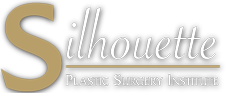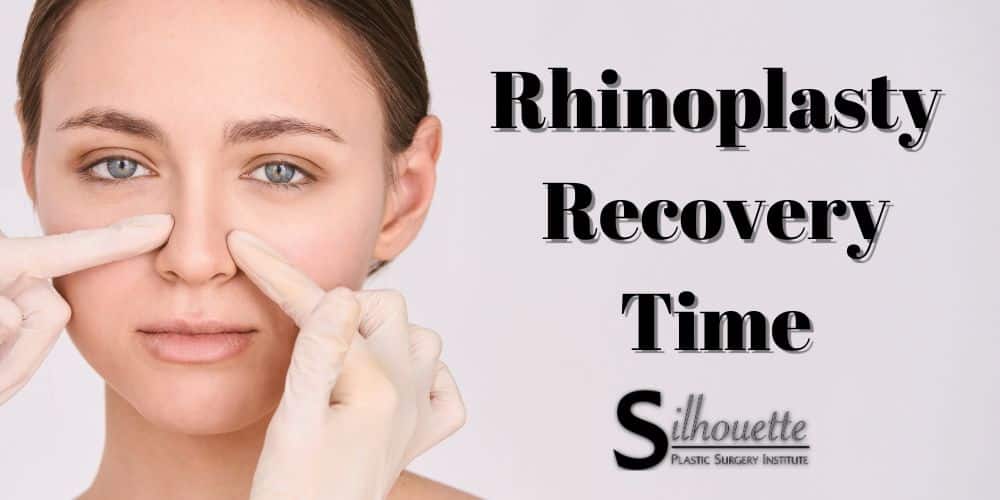Rhinoplasty procedures are the most common cosmetic procedure in the United States. With more than 350,000 rhinoplasty procedures performed in 2020, it’s no surprise that many people have the same questions: how long is the recovery period? What can I do after a nose job? What should I avoid after rhinoplasty? The average rhinoplasty recovery time is anywhere between six and eight weeks, but the actual time often depends on various factors. Your nose may not take it’s final shape for up to a year after the operation.
The experienced surgical team at Silhouette Plastic Surgery Institute wants to answer all your questions and provide you with all the details you need to make an informed decision about your operation. Dr. Daneshmand is a board-certified plastic surgeon who understands what goes into making a permanent decision about your appearance. For more information about the rhinoplasty recovery period, read on below. To schedule an appointment with Dr. Daneshmand at Silhouette Plastic Surgery Institute, call us today at 949-359-8397.
What is Rhinoplasty?
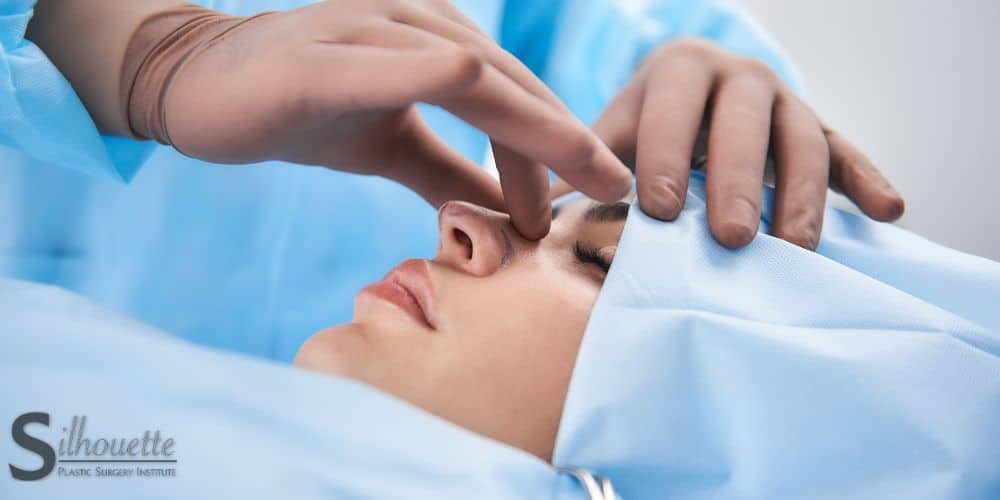
Rhinoplasty is a nose reshaping procedure. The cartilage, tissue, and other structures of the nose are reshaped to give a more pleasing appearance or fix a structural issue. Our talented plastic surgeon, Dr. Daneshmand, can help you design the nose that fits you best. Every nose job is different, just like every person is different. Different types of rhinoplasty procedures can give you different results, depending on what kind of look you’re going for.
Types of Nose Jobs
Rhinoplasty surgery can be open or closed, depending on the extent of the procedure and how much the patient wants to change their appearance. Open rhinoplasty surgery involves external incisions on the outside of the nose, so the surgeon can get better access to the internal structure of the nose. A closed rhinoplasty procedure has little to no external scarring since the incisions are made within the nostrils. In addition to these procedures, the team at Silhouette Plastic Surgery Institute offers three other types of rhinoplasty procedures.
- Revision Rhinoplasty. Sometimes a less experienced surgeon may make promises that they can’t keep, or take on a procedure that’s too complicated for them. If you aren’t happy with a nose job performed by a different surgeon, Dr. Daneshmand can help you. He can perform a revision rhinoplasty to fix the previous mistakes of the less experienced surgeon.
- Septoplasty. People suffering from a deviated septum often benefit greatly from a septoplasty. This surgery can change the nasal passages and septum to allow easier breathing.
- Non-surgical Rhinoplasty. If you’re not set on a permanent change, you can try a temporary, non-surgical rhinoplasty. This procedure is often called a liquid rhinoplasty. This procedure involves injecting dermal fillers or Botox into the nose to temporarily change the shape or appearance. The effects of this procedure are not permanent, but usually last for a few months. This gives someone time to try out a “new nose” before making the decision to permanently change their appearance.
No matter what kind of rhinoplasty you want, the team at Silhouette Plastic Surgery Institute can help.
Why Do People Get a Rhinoplasty Procedure?
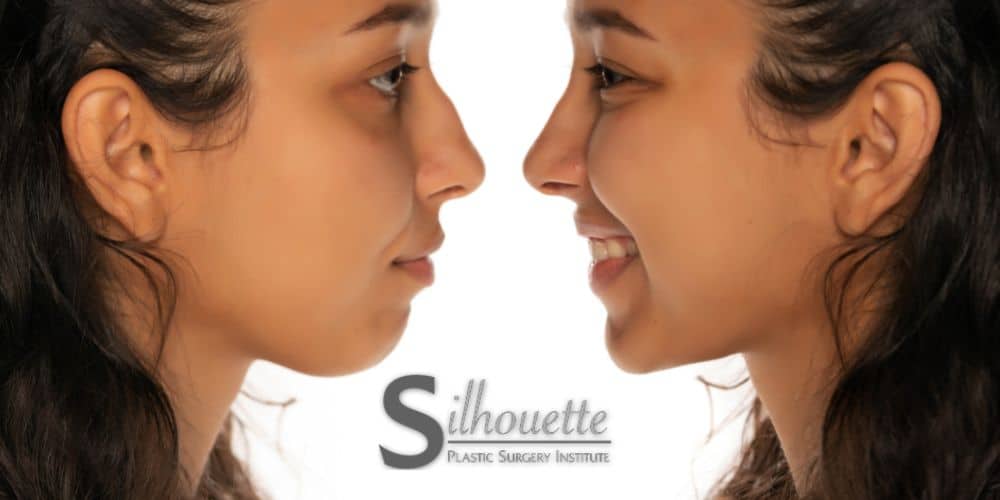
Plastic surgery is a way for people to express themselves and make their physical appearance match their aesthetic. Your nose is a major part of your face, and any lump or bump can take a major toll on your self-confidence and even perceptions of attraction. Sometimes people get a rhinoplasty to make their nose proportional to the rest of their facial features. Nose surgery can also help repair structural damage to your nasal passages after you’ve broken your nose. At Silhouette Plastic Surgery Institute, we can help you achieve the results you want. We can help you make major and minor changes to your appearance through various face, breast, and body procedures.
How Long Does It Take To Recover From a Nose Job?
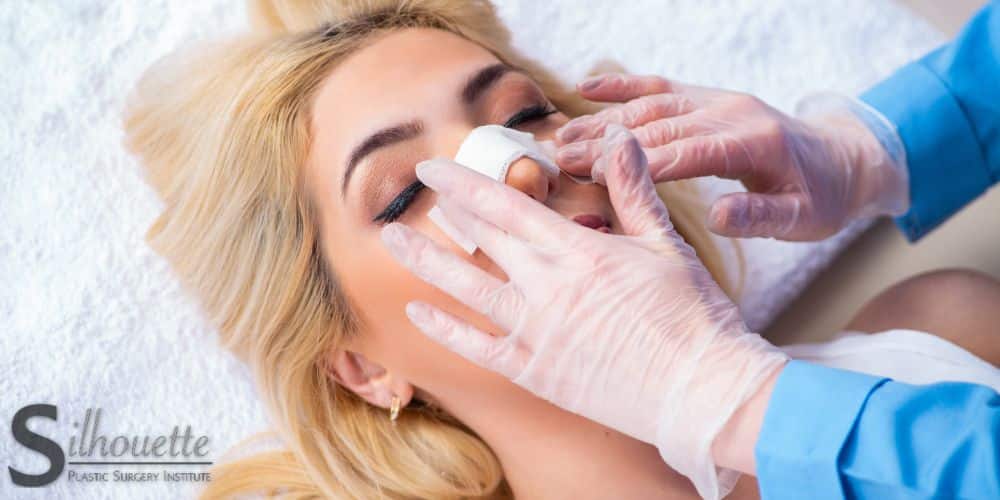
The recovery period from nasal surgery ultimately depends on the type of surgery and how well you follow instructions after the procedure. People who follow their doctor’s orders are more likely to have a smooth recovery than those who continue on with their normal life. These procedures often have large amounts of bruising and swelling, which can contribute to post-op discomfort. Rhinoplasty recovery time can vary from patient to patient, but most patients report that the bruising goes away after a week or two. Most people can go back to work and continue their normal day-to-day activities after a week. Unlike major surgery, rhinoplasty procedures are considered recovered when the appearance of the nose is normal again. Rhinoplasty procedures can take up to a year before the final results are set. Below, we go more in-depth about post-operative care and the recovery process for a rhinoplasty procedure.
Post-Op Care
Getting the proper post-op care after a nose job is an important part of the healing process. Knowing what to expect and how to handle any facial swelling can also reduce any stress that you may have about your appearance. Many people report seeing nose growth after a rhinoplasty procedure, but this is often due to swollen nasal tissues. Swelling can take months to fully dissipate, depending on the type of procedure and the amount of changes to your nose. You may see minor bruising immediately after the procedure, but this should go away within a few weeks.
Rhinoplasty Recovery Process

The rhinoplasty recovery timeline can be different for each patient and often depends on the type of procedure and individual factors. The healing process for rhinoplasty is broken down into common milestones below.
Immediately After Surgery
Immediately after surgery, you’ll likely spend some time in the recovery room as the effects of anesthesia wear off. Someone will have to drive you home and keep an eye on you overnight.
Week 1
During the first week after your procedure, you should get plenty of rest and take it easy while you heal. The discomfort and swelling will hit a peak around day 2 and day 3. If you have stitches, you’ll likely get them removed during the first week. If you have a nose splint or a nose cast, you’ll probably get them removed at a follow-up appointment around day 7 or 10.
Week 2
At two weeks post-op, all bruising should be gone and swelling should be greatly reduced. Your doctor may give you the go-ahead to resume your daily activities, but still be careful.
Week 4
At four weeks post-op, your surgeon may give you the go-ahead to resume exercises that increase your heart rate like light running and exercise.
Week 6
If the bones in your nose were broken, they should be healed by now. You can safely wear glasses, blow your nose, and do other activities that you’ve avoided all this time.
Months 3-6
You may have numbness or sensations in your nose that slowly return during this time period. It’s usually around this time that you take an ‘after’ picture for your before and after picture.
1 Year After Surgery
A year after surgery, the swelling should be completely gone and your nose shape should be finalized. This may seem like a long recovery process, but perfection takes time.
Tips for Healing After a Rhinoplasty Procedure

Healing after any procedure can be an uncomfortable process. So many of us touch our face or scratch our nose without thinking about it, and this can cause additional pain after facial plastic surgery. It’s important to be more aware of your body while you’re recovering. For a smooth recovery process, follow our rhinoplasty recovery tips below.
Watch For Signs of Infection
Depending on your procedure, you may have small incisions on the outside of your nose. Your surgeon will show you the proper way to clean the incisions with a cotton swab and apply a medicated ointment to promote healing. If you develop a fever or notice pus draining from any incisions, this could be a sign of infection. Contact your surgeon immediately if you notice these signs.
Reduce Swelling
Swelling is likely the main culprit for any discomfort after a rhinoplasty procedure. If you’ve ever had a head cold, you probably know that sinus pressure can be miserable. You can take some steps to keep swelling to a minimum:
- Keep your head elevated. Keeping your head in an upright position can prevent blood from pooling in your nose and increasing swelling. Keeping your head elevated can prevent further injury to your sensitive nose as well. Sleeping on your back or side can cause displacement, so many patients choose to sleep with lots of pillows propping them up or in a recliner.
- Use a cold compress. Cold compresses have been a popular option to reduce swelling for decades. Be careful not to apply direct pressure to your new nose, though, as this could undo the careful work the surgeon did. Apply the cold compress to your cheeks for 10-20 minutes at a time every 1 to 2 hours. Make sure to check the skin often to ensure your skin isn’t getting too cold.
- Avoid salty foods. Salty foods can increase swelling.
Stay Healthy
Staying healthy after any surgery is important. Make sure to eat a healthy diet of foods high in vitamins (especially vitamins C and D). Some foods like eggs, spinach, and vegetables can even help reduce inflammation and swelling. Consult your surgeon before resuming any exercise. Light walking is usually okay after the first week, but you should try to keep your heart rate and blood pressure low. Vigorous exercise should be avoided until you get clearance from your doctor.
Don’t Blow Your Nose
Your nasal passages will be very sensitive after a rhinoplasty procedure. Depending on the procedure, you may have to avoid blowing your nose for up to six weeks. You’ll likely have a buildup of pressure and mucus, but you can talk to your doctor about using a saline nose spray to help. The pressure from blowing your nose could cause more bleeding and swelling, which will extend your recovery time.
Listen to Your Doctor
Above all else, follow your doctor’s instructions after a rhinoplasty procedure (or any procedure, for that matter). If your doctor tells you to avoid an activity, there’s a reason you should avoid it. Your doctor will tell you how to have a smooth recovery and any medications or post-op care you need to take.
Nose Job Recovery FAQ
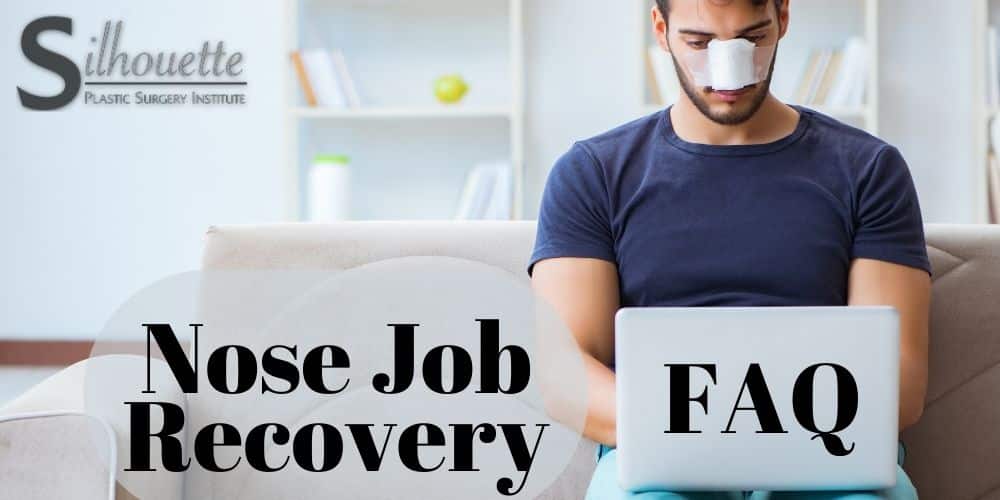
Will I Have A Nose Splint After a Rhinoplasty?
The nose cast may be an iconic look, but not everyone needs a splint after their procedure. A nose splint is only used if the nasal bones are broken and reset. The nose splint gives the bones time to heal in their new formation. Sometimes your surgeon may use an internal splint to give your nasal passages some structure during healing, but these are usually removed at your first follow-up appointment.
How Can I Speed Up My Recovery Time?
While there’s no miracle cure to speed up recovery, following your doctor’s advice can limit the number of complications with your procedure and ensure a smooth recovery. Eating a balanced diet with plenty of nutrients can keep your strength up and aid the recovery process.
Does a Rhinoplasty Procedure Hurt?
Depending on the type of procedure, your pain levels may vary. Most patients report feeling more discomfort than pain after a nose job. If you do experience pain or difficulty breathing after a rhinoplasty procedure, be sure to let your doctor know. Cold compresses, elevation, and over-the-counter anti-inflammatory medications may be all you need.
What Activities Should I Avoid After a Nose Job?
Your doctor may tell you to avoid many things after a nose job. These activities could include:
- Blowing your nose
- Strenuous exercise
- Sun exposure
- Bending down
- Showering until the cast comes off
- Wearing glasses
- Sex
These activities could increase your blood pressure and increase the chance of bleeding. You’ll want to avoid anything that raises your heart rate or puts unnecessary pressure on your new, fragile nose. Your doctor will give you clear instructions on what you should avoid and let you know when you can continue.
How Long Will Bruising Last After a Rhinoplasty Procedure?
After a rhinoplasty procedure, your nasal skin, cartilage, and tissue may be extra sensitive. Bruising may last a few days, but it ultimately depends on the person. Some people may bruise much easier than others and should expect more noticeable bruising.
When Can I Start Exercising After A Nose Job?
Always get permission from your doctor first, but most people can resume light exercise around a week after the procedure. Depending on your healing process, your doctor may clear you for more vigorous exercise early or ask that you wait a little longer. Exercise can increase your blood pressure and cause complications with the healing process.
When Can I Go Back to Work After a Nose Job?
Most people can return to work roughly a week after their procedure. If you are still self-conscious about any bruising or swelling, you can discuss potential accommodations related to your job with your employer. You may feel more comfortable working from home instead of working from the office until the noticeable swelling and bruising goes away.
Get the Results You Want With Silhouette Plastic Surgery Institute
The recovery process can be different for each patient. With thousands of rhinoplasty procedures under his belt, you can trust the highly qualified Dr. Daneshmand at Silhouette Plastic Surgery Institute. Our Bakersfield plastic surgery team can guide you through the entire process, from consultation through the end of the recovery period. For more information about our services, contact us at 949-359-8397.
